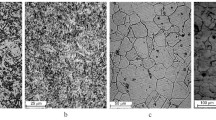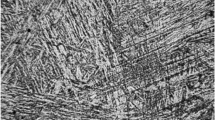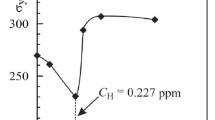In high ranges of pressure and temperature, hydrogen reduces the thresholds ∆K th, cyclic fracture toughness K fc , and short-term static crack resistance K c of 10Kh15N27T3V2MR austenitic dispersion-hardened steel. Conditions of plane deformation and, correspondingly, conditions of determination of the characteristic K Ic are maintained in testing in the range 293 – 483 K of compact specimens 20 mm thick after their preliminary hydrogenation to a hydrogen content of 8 ppm. Low-cycle fatigue and sizes of the plastic zone under static crack resistance are most sensitive to hydrogen (and decrease by 80 and 70%, respectively, against those in helium), and the cyclic crack resistance parameters ΔK th and K fc (decrease by 25%) are least sensitive to hydrogen. The static crack resistance K c and the percentage reduction in the cross-sectional area ψ in short-term tension are reduced by 50%.
Similar content being viewed by others
References
A. I. Balitskii and V. V. Panasyuk, “Workability assessment of structural steels of power plant units in hydrogen environments,” Probl. Prochn., No. 1, 69–75 (2009).
O. E. Andreikiv, H. M. Nykyforchyn, and V. I. Tkachov, “Strength and fracture of metallic materials and structural elements in hydrogen-containing atmospheres,” in: Physicomechanical Institute: Progress and Achievements [in Ukrainian], Lviv (2001), pp. 248–286.
A. I. Belogurov, V. S. Radchuk, M. A. Rudis, et al., “Strength analysis of structural elements of hydrogen power-generating equipment,” Fiz.-Khim. Mekh. Mater., 40, No. 6, 89–94 (2004).
V. I. Tkachov, L. M. Ivas’kevich, and V. M. Mochul’s’kyi, “Temperature dependences of mechanical properties of austenitic and martensitic steels in hydrogen,” Fiz.-Khim. Mekh. Mater., 43, No. 5, 53–64 (2007).
C.T. Sims and W.C. Hagel, The Superalloys, Wiley, New York (1972).
F. F. Khimushin, Refractory Steels and Superalloys [in Russian], Metallurgiya, Moscow (1978).
V. I. Tkachev, L. M. Ivas’kevich, and V. I. Vitvitskii, “Features of determination of the susceptibility of steels to hydrogen degradation,” Al’tern. Energ., 32, No. 12, 46–51 (2005).
A. W. Thompson and I. M. Bernstein, “The role of metallurgical variable in hydrogen assisted environmental fracture”, in: M.. G. Fontanna and R. W. Staehle (editors), Advances in Corrosion Science and Technology, Vol. 7, Plenum Press, New York (1980), pp. 53–175.
GOST 25506-85. Methods of Mechanical Tests of Metals. Determination of Crack Resistance (Fracture Toughness) Characteristics under Static Loading [in Russian], Izd. Standartov, Moscow (1985).
W. F. Brown and J. E. Srawley, Plane Strain Fracture Toughness Testing of High Strength Metallic Materials, American Society for Testing and Materials, Philadelphia (1966).
V. B. Shepilov, A. V. Mikhailov, N. P. Antropov, et al., “Influence of hydrogen on the mechanical properties of EP-33 steel with intermetallic hardening,” Fiz. Met. Metalloved., 62, No. 5, 1002–1006 (1986).
V. V. Panasyuk, Mechanics of Quasibrittle Fracture of Materials [in Russian], Naukova Dumka, Kiev (1991).
M. M. Shved, Change in the Operating Properties of Iron and Steel under the Influence of Hydrogen [in Russian], Naukova Dumka, Kiev (1985).
G. P. Cherepanov, Mechanics of Brittle Fracture [in Russian], Nauka, Moscow (1974).
J. R. Rice, “Mechanics of crack tip deformation and extension by fatigue,” in: Fatigue Crack Propagation, ASTM STP 415 (1967), pp. 247–309.
P. Macintyre, “The interaction of hydrogen with steel in the process of cyclic loading,” in: Proceedings of the 1st Soviet–English Seminar [in Russian], Naukova Dumka, Kiev (1982), pp. 113–115.
O. M. Romaniv, Yu. V. Zima, and G. V. Karpenko, Electron Fractography of Hardened Steels [in Russian], Naukova Dumka, Kiev (1974).
L. Engel and H. Klingele, Scanning Electron Microscopy: Fracture. A Handbook, Carl Hanser, Munich (1982).
Author information
Authors and Affiliations
Corresponding author
Additional information
Translated from Fizyko-Khimichna Mekhanika Materialiv, Vol. 45, No. 2, pp. 102–110, March – April, 2009.
Rights and permissions
About this article
Cite this article
Balyts’kyi, O.I., Ivas’kevych, L.M., Mochul’s’kyi, V.M. et al. Influence of hydrogen on the crack resistance of 10Kh15N27T3V2MR steel. Mater Sci 45, 258–267 (2009). https://doi.org/10.1007/s11003-009-9184-5
Received:
Published:
Issue Date:
DOI: https://doi.org/10.1007/s11003-009-9184-5




